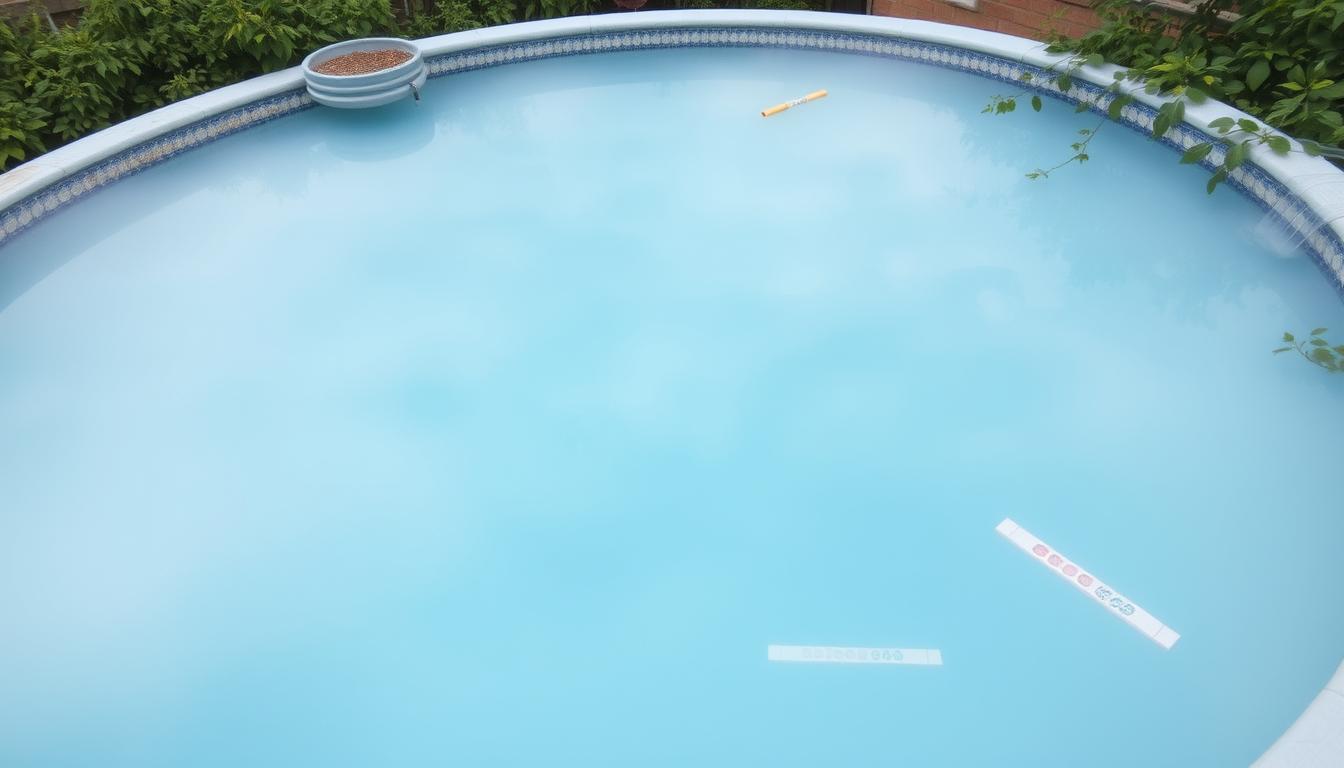
Waking up to a cloudy pool can be frustrating. Fortunately, there are solutions to restore your pool’s sparkle. Cloudy water can stem from chemical imbalances, poor filtration, or environmental factors.
Understanding the causes and using proper maintenance techniques can quickly clear your pool. With the right approach, you can solve the problem and prevent future cloudiness.
Clear pool water is vital for a healthy and fun swimming experience. Cloudy water looks unappealing and may signal underlying issues. These problems could include low chlorine, algae growth, or a faulty filtration system.
Identifying the cause is crucial to finding the right solution. With proper knowledge and tools, you can effectively tackle and prevent cloudy pool water.
Key Takeaways
- Chemical imbalances are the most common cause of cloudy pool water
- Poor filtration, such as dirty filters or inadequate system size, can lead to cloudy pools
- Environmental factors like pollen, dust, leaves, and sunscreen can contribute to cloudiness
- Using a pool clarifier can help coagulate particles for easier filtration
- Regular pool maintenance, including testing and adjusting chemicals, enhancing filtration, and removing debris, is crucial for maintaining crystal-clear water
Common Causes of Cloudy Pool Water
Cloudy above ground pool water can be frustrating. Several factors contribute to this issue. Understanding these causes is key for maintaining a clean swimming environment.
Let’s explore the most common culprits behind cloudy pool water. We’ll also discuss how to address these problems effectively.
Chemical Imbalances
Chemical imbalance is a primary reason for cloudy pool water. Incorrect pH levels, chlorine concentration, or calcium hardness can foster bacteria and algae growth.
Regular pool water testing helps identify and correct these imbalances. The ideal pH range is 7.2 to 7.8. Combined chlorine content should be below 0.2 parts per million.
Poor Filtration
A pool’s filtration system removes impurities and maintains water clarity. Dirty, clogged, or underused filters can result in cloudy water.
Backwash the filter every few days. Ensure it runs for enough time daily. Running the system for 24 hours can jumpstart the cleaning process.
Environmental Factors
External factors can contribute to cloudy pool water. Pollen, dust, leaves, and sunscreen can overwhelm the filtration system.
Regularly skim the pool’s surface and vacuum debris from the bottom. Covering the pool when not in use prevents unwanted contaminants.
Algae Growth
Early-stage algae can make water appear cloudy. They thrive in pools with low chlorine levels.
Test pool water and balance chlorine levels weekly. This prevents algae growth and maintains clarity. Shock the pool with high chlorine if algae persist.
| Cause | Effect | Solution |
|---|---|---|
| Chemical Imbalances | Bacteria and algae growth | Regular water testing and balancing |
| Poor Filtration | Impurities remain in water | Backwash filter and increase running time |
| Environmental Factors | Disrupts chemical balance | Skim surface, vacuum debris, and use pool cover |
| Algae Growth | Cloudy water and visible patches | Maintain proper chlorine levels and shock if necessary |
Solutions to Clear Up Your Pool
Cloudy pool water can be fixed with the right approach. By balancing chemicals, improving filtration, and using targeted treatments, you can restore your pool’s clarity. Let’s explore how to make your pool sparkle again.
Test and Adjust Pool Chemicals
Start by testing your pool’s water chemistry. Use a reliable kit to check pH, alkalinity, and chlorine levels. Aim for these ideal ranges:
| Chemical Parameter | Recommended Range |
|---|---|
| pH | 7.4 to 7.6 |
| Alkalinity | 80 to 120 ppm |
| Free Chlorine (traditional or saltwater) | 1 to 3 ppm |
If levels are off, use appropriate chemicals to adjust them. Balanced chemicals are key to a clear and healthy pool.
Enhance Filtration
Your pool’s filter is crucial for maintaining clear water. To improve its performance, follow these tips:
- Run your filter and pump for 8 to 12 hours daily.
- Clean your filter regularly by backwashing or hosing down cartridges.
- Consider upgrading to a larger or more efficient model if needed.
Shock Your Pool
For severely cloudy pools, shock treatment can be effective. It’s a concentrated chlorine dose that eliminates contaminants. Here’s how to shock your pool:
- Test and adjust pH and alkalinity levels before shocking.
- Choose a quality shock product for your pool type and size.
- Follow the manufacturer’s instructions for dosage and application.
- Run your pool filter for at least 24 hours after shocking.
- Retest water chemistry and adjust as needed.
Vacuum and Brush the Pool
Regular cleaning is essential for clear water. Vacuum your pool weekly to remove debris from the floor. Brush the walls and floor every few days to dislodge algae and bacteria.
Use a Pool Clarifier
If cloudiness persists, try a pool clarifier. It clumps tiny particles together, making them easier for your filter to remove. Add the recommended dose and let your filter do the work.
By following these steps and maintaining good habits, you’ll enjoy a crystal-clear pool all season long.
Preventive Measures for Maintaining Crystal Clear Pool Water
Keeping pool water clear is easier than fixing cloudiness. Follow a regular cleaning and maintenance schedule. Test pool water weekly to ensure proper pH and chlorine levels.
Monitor and adjust chemical levels consistently. This prevents imbalances that cause cloudy water and algae growth. Proper maintenance also prevents other pool issues.
An adequate pool filtration system is crucial. It should suit your pool size and be in good condition. A well-functioning system removes contaminants, dirt, and debris.
Run your pool’s filter 24/7 for proper circulation. This prevents stagnation. Backwash the filter occasionally to keep it clean and efficient.
Use a pool cover when not in use. This reduces environmental contaminants like leaves, pollen, and dust. These can disrupt water balance and cause cloudiness.
Have a professional check your pool regularly. This ensures proper chemical balance and circulatory system function. It prevents potential issues that may lead to cloudy water.







